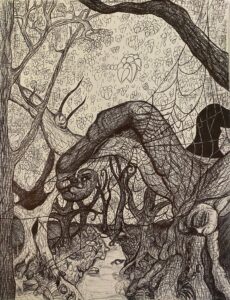
Made by Monica Cummings, titled ‘Waldeinsamkeit’
This modern ink sketch depicts a Linden forest landscape with a beaten path cutting through it. Done completely in black ink with crosshatched shading to mimic 19th century engravings, the attention of the piece splits between two focal points; the path’s ending in the near center two-thirds of the way down the sketch, and the hub of an overhanging spiderweb in the right center. Lack of consistant shading represents the uneven lighting caused by leaf-cover in dense forests such as Germany’s Schwarzwald. The underbrush contains rocks, ferns, ivy, moss, and other foliage typical of Germany, with a stream cutting through the left corner. The backgroung contains nine Linden trees with resulting forest canopy. The image contains an upside down figure in the fetal position depicted through the negative spacing outlined by combination of the three closest Linden trees, and a large, knarled branch arching across the center.
Waldeinsamkeit, often translated as ‘forest solitude,’ refers to the German tradition of seeking out alone time in the woods for a sense of recovery and meditation. The word inself combines melancholy or negative feelings with the inclusion of lonliness, as well as enlightened, sublime feelings that come from fully experiencing the woods. Furthermore, forest landscapes relate to the development German nationality during Romantic Era. Fairy tales and short stories such as the collected works of the Brother’s Grimm, artworks by Caspar David Friedrich and poetic works put to song such “die Schoene Muellerin” by Schuman utilize the woods to express German identities.
A critical part of the German romantic forest stems from the inherent juxtoposition of danger and sublimity. Depitctions of forest landscapes in Romantic artworks contain both aesthetic beauty, holiness, or some type of positive power, as well as hexes, villains, and life-threatening terrains. Yet it’s into these landscapes that German’s seek renewal and peace of mind through Waldeinsamkeit. With it’s dark coloring and relatively unclear focal point, the image above contains the elements of inviting beauty and forboding unease seen in the Romantic Forest. This is difficult to express unless done visually. The upside down fetal figure represents the potential for renewal or ‘rebirth’ one gets through forest solitude, but also the potential for identity loss and complete seclusion from society one can feel when alone in the woods. In combination of Märchen symbols (such as Linden trees and forest paths,) contrasting emotions and the potential for rebirth, this image hopefully captures the complexities of Waldeinsamkeit and the Romantic Forest.
